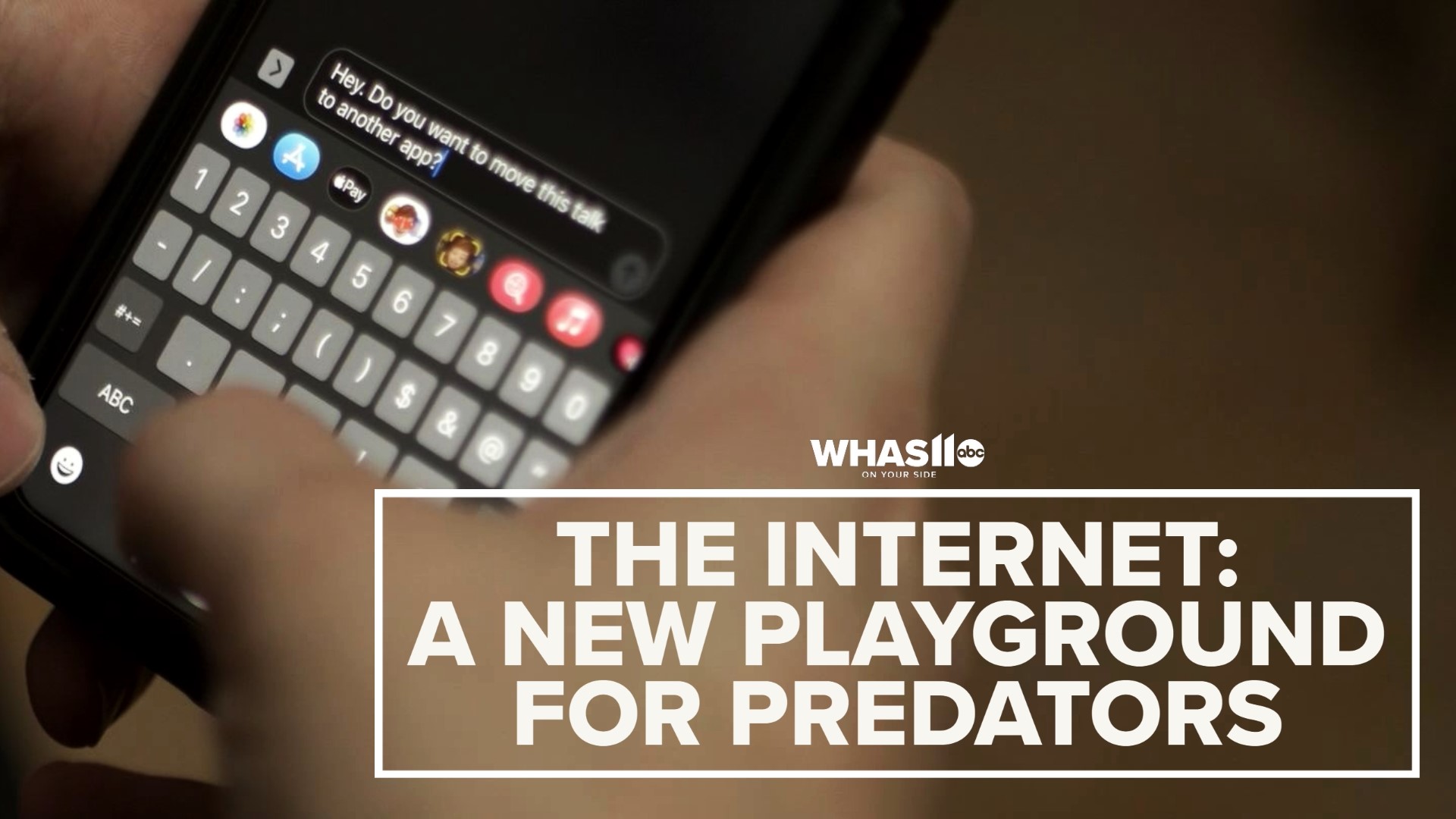LOUISVILLE, Ky. — Give a child a cell phone and they have access to the world. But the world now has access to them.
It's a hard truth parents across the country are learning as law enforcement agencies take on a record number of child exploitation cases - and it's playing out across Kentuckiana.
Online predators are capitalizing on children with unlimited access to the internet through social media and online gaming, and police are using that intelligence to put them behind bars.
Seven Kentucky men, caught in a November 2020 sting operation, are facing 10 years to life in prison for a number of child sex crimes. In their case, the 'victims' were undercover officers.
But the reality across the state is far more tragic. Law enforcement agencies are working hundreds of similar cases across Kentucky, and those are just a fraction of the thousands of complaints they receive every year.


It starts small...
"The accessibility to our kids makes them a perfect target and they're vulnerable, they trust. They don't believe someone's trying to lie to them," Jeremy Wright, a Supervisory Special Agent with the FBI Louisville division said.
Wright is the father of three boys and knows how quickly a simple chat can lead to something sinister. He said criminals find children on social media accounts like Facebook, Instagram and Snapchat and, many times, will ask to move the conversation to another messaging platform, like Kik.
"Kik hasn't intended it to go this way, but it's become this underground messaging platform, and you can have different groups, like, you know, 'Pervs in KY', and 'I Like Young Boys.' It's really creepy," Wright said.
"You can communicate, you can chat, you can speak, you can send messages. It's an independent form of communication even when you're not playing the game, like an app," Wright said.
What kids can't see is the person they're talking to can be just as fictional as the characters they're controlling.
Wright said he had a recent case where a 48-year-old registered sex offender in Kentucky was posing as a young boy on Facebook and Instagram, targeting children in multiple states.
"He had a tagline, 'Hey beautiful.' Every time," Wright said. "Many times, it didn't work, but how many times does it take before you victimize a child and completely change their life?"
Wright says that's when the 'grooming' begins.
"It starts more modest. It's a clothed picture and then, 'Oh, I need more,' and the compliments start coming. Eventually, they feel more comfortable, and then it becomes more nudity, and the videos are more sexual in nature."
The end goal: to meet that child for sex.
"If they can't talk them into doing what they want, they're going to threaten them, what we call sextortion," Wright said.
Who's working to stop these crimes?
The FBI is one of a handful of agencies across the state and nationwide working to crack these cases, with forensic specialists working around the clock.
"Our job has become increasingly more difficult with all the data on the market these days," said Kimberly Milka, a Supervisory Special Agent with FBI Louisville and the director of Kentucky Regional Computer Forensics Laboratory.
It's a rare glimpse into the FBI's crime lab in Louisville. Specialists are sifting through cell phones, laptops, DVRs, even the data in your car system for any evidence that could put a predator behind bars.
"If we can't find it, we can find people who do," Milka said.
This space is offered to local, state and federal police departments, each with its own caseload. Many receive their cyber tips from internet providers and social media companies who are required to notify the National Center for Missing & Exploited Children (NCMEC) when they find explicit images.
Just look at these numbers from a recent New York Times investigation.
- In 1998, more than 3,000 child sexual abuse images were found circulating online.
- Just 2 years later, that number jumped to 100,000.
- By 2018, over 45 million images and videos were flagged as "child sexual abuse" on the dark web.
Helping kids in Kentuckiana
"I don't think anyone would have fathomed we'd be where we are now," Pam Darnall, the CEO of Family and Children's Place in Louisville said.
The center works closely with LMPD's Crimes Against Children unit to prevent child abuse and neglect, to stop it when it happens, and help affected families heal. Child advocacy centers like Darnall's play a huge role in these investigations, which hit a spike during the pandemic, when both kids and adults were forced to stay home, spending even more time than usual online.
"We saw more kids here at this child advocacy center than we've seen in six years," Darnall said. Family and Children's Place covers ten Kentucky counties and five in Southern Indiana.
"Out of over 1,500 children that we saw last fiscal year, about 30 percent of those were related to cyber and internet crimes," Darnall said.
Trained staff go into these interviews with children blind, knowing few details aside from the victim's age and name. It's up to the child to reveal their story.
"What sometimes happens with kids who, who aren't cared for at home, is that they'll look outward, right? They'll look outward for a sense of belonging or someone to care, and recently, there was a youth who did that...and began sharing some images, and the intent of that adult who was connecting with that youth was to take that youth to a different state," Darnall said.
She said police caught onto the predator before it got that far. But not every case is as successful.
"Sometimes, kids are threatened," Darnall said. She said predators will offer money or gifts to the children they're hurting to keep the relationship going.
"Sometimes kids have a really difficult decision to make," she said. "But one of the important things to remember is that is not the responsibility of that child. It is still the adult who hurt that child, and it is our job, as adults, to do the very best we can to find out what is happening to keep that child safe."
What happens when someone gets caught?
The minimum sentence for most of these child exploitation crimes is 15 years at the federal level. Wright said the majority of his cases never make it in front of a jury.
"Not one went to trial, for many reasons," he said. "Evidence was outstanding against them and two, once it goes to trial, the details become public and they don't want that."
Even prison isn't enough to stop the worst criminals - Kentucky has several repeat offenders.
Last year, state and local police agencies made 88 arrests across Kentucky related to child exploitation, adding up to 520 counts, according to the Kentucky Attorney General's Office.
This year, that number sits at 58 arrests. These numbers more than double once you add in cases handled at the federal level, involving the FBI, Secret Service and Homeland Security.
What you can do to protect yourself, your kids
"At this point, it's up to us as parents, school administrators, as citizens to do what we can to educate our kids to make sure they don't fall prey to that," Wright said.
Here are some tips you can share:
- Never send compromising images of yourself to anyone, no matter who they are - or say they are.
- Do not open attachments from people you don't know. Links can secretly hack your electronic devices by using malware to gain access to your private data including photos and contacts. Plus, hackers can use this technology to control your web camera and microphone without your knowledge.
- Turn off your electronic devices and web cameras when not in use.
You can see additional tips and suggestions here or on the FBI website.
If you are receiving threats, remember that you are not alone - thousands are victimized by this scam every year. Stop all interaction with the other person and contact law enforcement.
You can file a complaint with the FBI IC3 here.
Contact reporter Brooke Hasch at bhasch@whas11.com. Follow her on Twitter (@WHAS11Hasch) and Facebook.
Make it easy to keep up-to-date with more stories like this. Download the WHAS11 News app now. For Apple or Android users.
Have a news tip? Email assign@whas11.com, visit our Facebook page or Twitter feed.

